To wrap up my positional review of the Nashville Predators’ 2018-19 season, I move to their goaltenders. For reference, here are the reviews I’ve written thus far:
The 2018-19 season was a rough one for goaltenders. League-wide, netminders had a .910 save percentage (SV%), the lowest since 2008-09. Simultaneously, they had a 2.81 goals-against average (GAA), the highest since 2005-06. The Predators are a team that relies heavily on its goaltenders, and their .914 SV% was fourth-highest in the league during the regular season. This is a review of the team’s netminders, how each did this season, and the biggest question concerning the position in 2019-20.
Pekka Rinne
Long-time goaltender Pekka Rinne entered the 2018-19 season as the reigning Vezina Trophy winner after he posted a .927 SV% in 2017-18. This season was his 13th in the NHL, all with the Predators, and was his age-36 campaign. Still, despite his age, no dropoff in performance was expected.
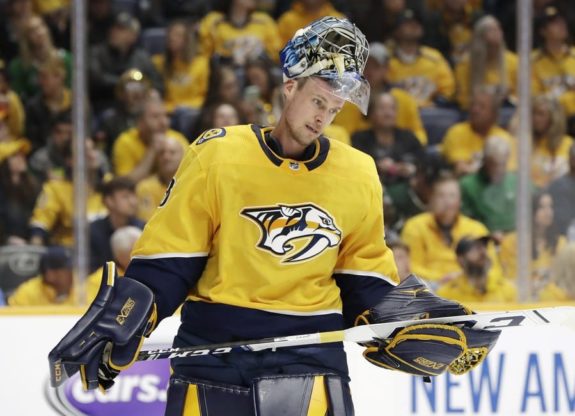
What’s interesting about Rinne is that he never projected as an elite goaltender. He never had strong numbers in Finland or the AHL, but has always been good in the NHL. Part of it has to do with him being 6-foot-5, but what makes him a great goaltender is that his size never came at the expense of athleticism, sometimes even relying on it too much. In recent seasons he changed his style, playing deeper in the net in order to cut down angles and not have to cover so much distance to face different shots. It’s part of what helped him win the 2018 Vezina Trophy.
Related: Rinne Extension Provides Predators with Plenty of Positives
Regular Season
Rinne made 55 starts in 2018-19, his fewest since 2013-14. He accumulated a record of 30-19-4, and his wins were also his fewest since 2013-14. He posted a .918 SV%, matching his career average, and a 2.42 GAA, above his career average of 2.38. He saved 12.50 goals above average, a metric that measures how many goals a goaltender prevented relative to league average.
At five-on-five, he had a .929 SV% with a .921 expected save percentage (xSV%), so he played well above expectations. His five-on-five save percentage is actually above his career mark (.928), even if it was lower than the .938 SV% he had in 2017-18. Looking at how he fared against different shot qualities paints an interesting picture. Against low-danger shots, he had a .974 SV%, matching his mark from last season. Against medium-danger shots, a .913 SV%, significantly lower than the .935 he turned in last season. Finally, against high-danger shots, he had an .858 SV%, higher than the .833 from 2017-18.
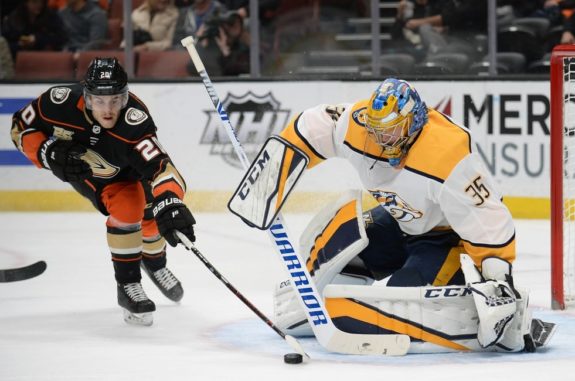
The Predators allowed him to face 1.75 rush attempts and 2.71 rebound attempts per-60. Those were more rush attempts but fewer rebound attempts than last season. Lastly, he faced an average shot distance of 35.8 feet, nearly two feet closer than the 37.1 foot average of 2017-18.
On the penalty kill, Rinne turned in an .861 SV%, his lowest in three seasons. That was lower than his .874 xSV%, and largely the result of a .768 SV% against high-danger shots. He faced 47.5 shots per-60 while shorthanded. By comparison, in 2017-18 he had an .869 SV%, an .870 xSV%, and faced 53.9 shots per-60 on the penalty kill. So even though the Predators’ penalty kill improved from 81.9 percent in 2017-18 to 82.1 percent this season, Rinne wasn’t the reason for it. He struggled while shorthanded even though he faced fewer shots per-60.
Rinne allowed two or fewer goals in 31 regular-season games this season and the Predators went 24-5-2 in those games. His 31 games tied for seventh-most in the league. He had 25 games in which he allowed three or more goals, which tied for 19th-most. The Predators had a 7-15-3 record in them. So it’s clear that Rinne needed to be stingy for the Predators to win consistently.
Playoffs
Throughout his career, Rinne has been an amazing regular-season goaltender. However, it’s been a different story in the postseason, with a .915 SV% and a 2.45 GAA in 83 games entering this season. So when the Predators began the 2019 Playoffs, fans were cautiously optimistic at best when it came to Rinne. And for the second straight season he showed why they should have been.
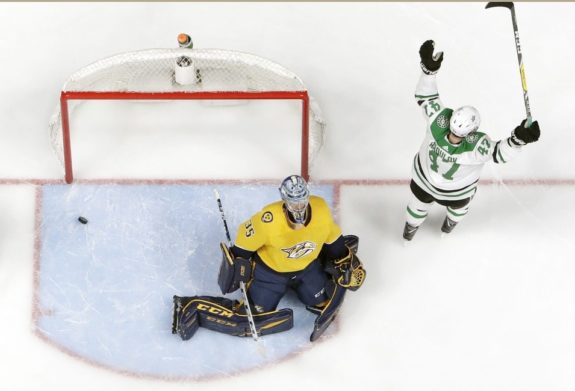
In six games he had a .905 SV% and a 3.09 GAA. He allowed at least three goals in three games and was pulled less than 14 minutes into Game 4 after he allowed four goals on eight shots. Rinne’s problem in the postseason is consistency. This season he had three games with a save percentage over .950 and three with less than a .900 SV%.
At five-on-five, he had a .904 SV% while facing 31 shots per-60, the same amount he faced in the regular season. On the penalty kill, he had an .897 SV% while the team allowed him to face a whopping 67.7 shots per-60 minutes, including 17.4 high-danger shots per-60. The team’s defense essentially hung him out to dry during the postseason.
For comparison’s sake, during the regular season, the Predators averaged 29.7 shots against per-60 in all situations. During the postseason, it jumped to 31.4. Rinne may have struggled in the playoffs, but the poor results weren’t entirely his fault.
Juuse Saros
Juuse Saros is the Predators’ backup goaltender and their future in net. Having just turned 24, his future is incredibly bright. This season was his third as an NHL regular and he’s increased his playing time each season to the 31 appearances he made in 2018-19. Like Rinne, Saros is Finnish, but at 5-foot-11, Saros isn’t nearly as big as Rinne; in fact, he’s not even big relative to other NHL goaltenders.
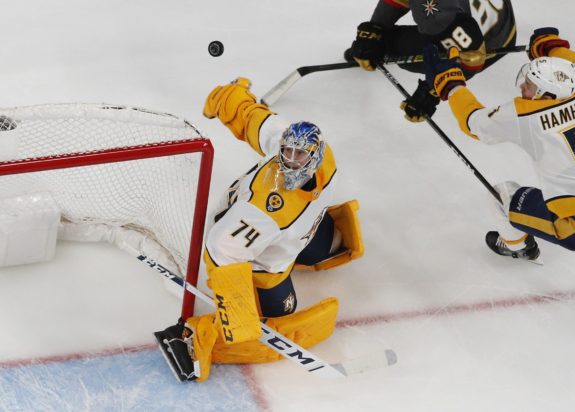
He entered 2018-19 as the clear backup, but was expected to take on a bigger role. When he signed his three-year extension last July and Rinne signed his own two-year extension in November, it became clear that the plan was for Saros to earn bigger shares of the workload until they split starts or Saros earns the majority of them. So because of that there were high expectations for him this season.
Regular Season
Saros’ 2018-19 season wasn’t as strong as many would have liked. In 31 appearances he had a 17-10-2 record. Those were the most appearances and wins of his career. He turned in a .915 SV% and a 2.62 GAA, his lowest and highest, respectively, since he became an NHL regular in 2016-17. He also saved 4.41 goals above average.
At five-on-five, he had a .923 SV%, slightly higher than his .921 xSV%, and he was adequate against all three shot difficulties. Against low-danger shots he had .963 SV%, against medium-danger shots a .936 SV%, and against high-danger shots he turned in an .800 SV%. He was worse in 2018-19 against low-danger and high-danger shots than he was in 2017-18.
However, he did face 31 five-on-five shots per-60, slightly more than Rinne faced, although Rinne faced more high-danger chances. Saros did average more rush and rebound attempts per-60 with 2.38 and 3.86, respectively. Yet he did face an average shot distance of 36.5 feet, almost a foot further than Rinne, and a longer distance than he faced in 2017-18.
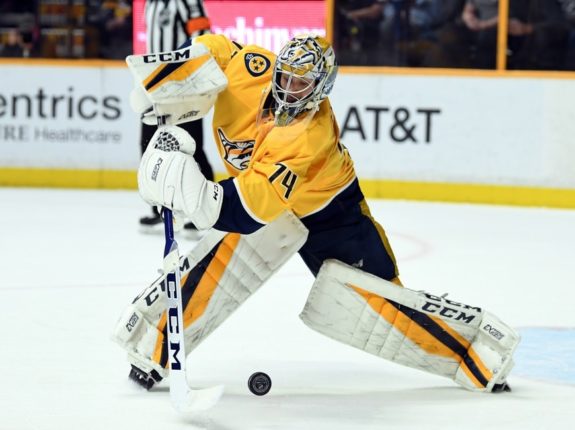
On the penalty kill, he had an .880 SV%, another career low, but he played better than his .864 xSV%. By comparison, he had an .899 SV% and an .865 xSV% in 2017-18. In 2018-19 he faced 48.4 shots per-60, including 13.1 at high-danger. Both were more than Rinne faced, but significantly less than he faced a season ago. So once again, even though the Predators improved their penalty kill, it wasn’t due to Saros’ individual performance. What I think it came down to was the team taking 48 fewer penalties in 2018-19 than they did in 2017-18.
During the regular season, Saros allowed two or fewer goals in 18 of his 31 appearances. The Predators went 14-3-1 in those games. Conversely, he allowed at least three goals in 13 games and the team had a 3-9-1 record in them. So his performance impacted the Predators even more than Rinne’s did.
Playoffs
As the backup, Saros wasn’t expected to play much in the postseason, and ideally he wouldn’t have played at all. In this season’s playoffs he only played in one game, relieving Rinne in Game 4. Saros played over 45 minutes in that game, stopping 20 of 21 shots for a .952 SV%. He was able to stop the bleeding, but was put in the game too late and the Predators lost the game. It’s the third straight season in which he made a playoff appearance and the second straight that he had better numbers than Rinne, albeit in a smaller sample size.
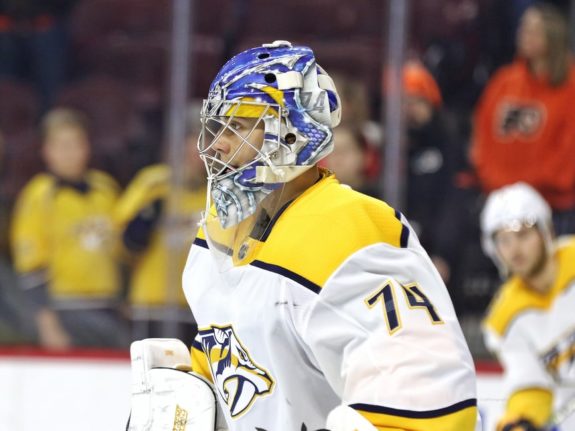
Comparing the Two Goalies
While Rinne is still the starting netminder for the Predators, the gap between he and Saros is closing. Of the two, Rinne is bigger, the better puck handler, and makes the more athletic-looking saves. Meanwhile, Saros is the calmer and more technically-sound of the two, and is a strong puck handler is own right. The two had similar numbers in 2018-19 with Rinne having the much larger sample size. Even the heat maps convey this.
With Rinne in net, Predators’ opponents were an average threat at five-on-five, and he faced an incredible amount of chances from directly in front of the net. With Saros in net, opponents were a minus-one percent threat and the majority of the chances he faced came from the high slot.
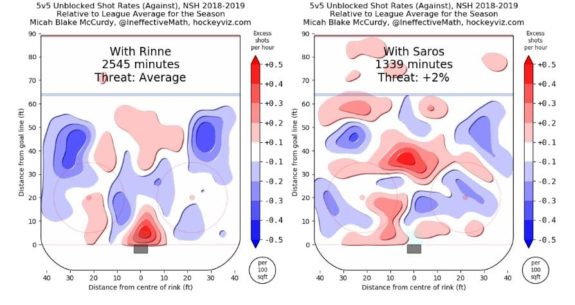
On the penalty kill, the Predators were a stifling team, but were stronger with Rinne in net. When he was playing, opponents were a minus-19 percent threat to score and the team allowed a less-than-average amount of chances from the low slot. With Saros playing, opponents were a minus-nine percent threat. Still good, but not as good, as the Predators allowed more chances from the slot with him in net.
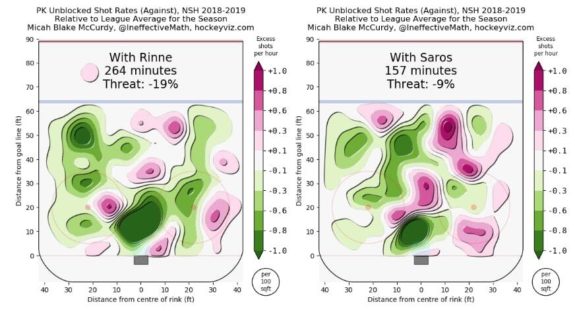
Question for 2019-20
What Does Playing Time Look Like?
If Saros is the heir apparent to the net and Rinne’s successor, when does he begin receiving an even split of starts or receive the majority? With two years left on both players’ contracts and Saros needing a big raise on his next deal, 2021-22 is the season in which he has to be the starter. That means between now and then he needs to take over the net. Beginning next season it’d be nice to see he and Rinne split starts. There are many reasons supporting this.
For one, it’d keep both goaltenders fresh. With neither playing significantly more than the other, it means both enter the postseason rested. It’s a trend we’re seeing across the league. In 2018-19, 17 goaltenders made at least 50 starts, down from 20 the season before. Of those 17 players, nine reached the postseason. However, only two won a round. Of the four teams who reached the Conference Finals, only the San Jose Sharks’ Martin Jones made 50-plus starts with 62, and he isn’t exactly carrying his team. Of the other teams to advance that far, none had a starting goaltender make more than 45 starts during the regular season.
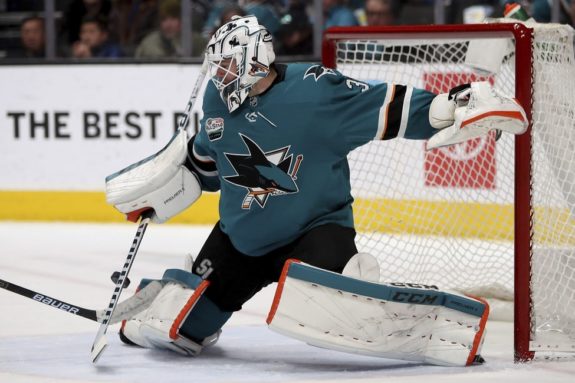
Want more evidence supporting a playing time split? Neither the New York Islanders nor the Dallas Stars, the two teams with the fewest goals against in the regular season, had a goaltender make more than 45 starts. Dallas’ Ben Bishop made 45 starts and Anton Khudobin received 37, while the Islanders’ Robin Lehner made 43 starts and Thomas Greiss had 39. So if it would help Rinne in the postseason, why not play Saros more?
Another reason to begin giving Saros more starts is because the Predators will want him accustomed to playing a lot when he does become the starter. He hasn’t received the majority of starts since 2014-15 when he was still in Finland, so throwing him into the fire when Rinne is gone wouldn’t be smart.
On paper, the Predators have one of the best goaltending situations in the league. Rinne has been a perennial Vezina candidate for much of his career, while Saros is a future contender for the award. However, with head coach Peter Laviolette relying on Rinne as much as he does, Saros hasn’t been given the opportunity to perform, and it’s hurting the team. In 2019-20, that needs to change, and Laviolette using Saros more will help the team, both in the regular season and playoffs.
*All stats come from Hockey-Reference, Natural Stat Trick, Elite Prospects, HockeyViz, and Corsica